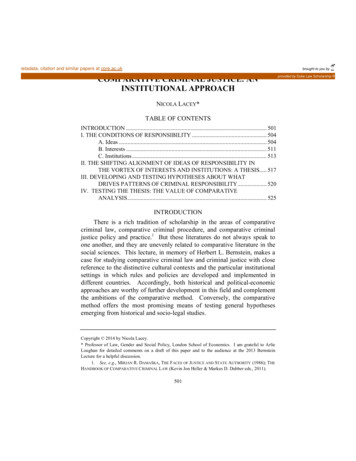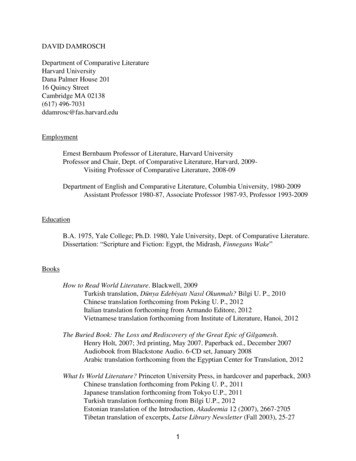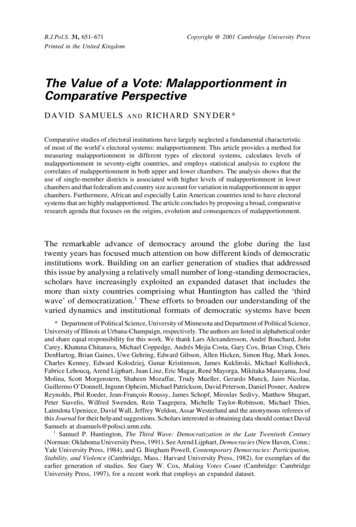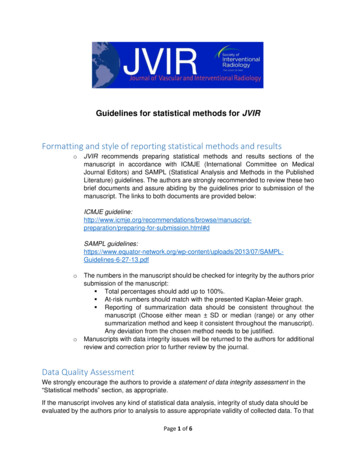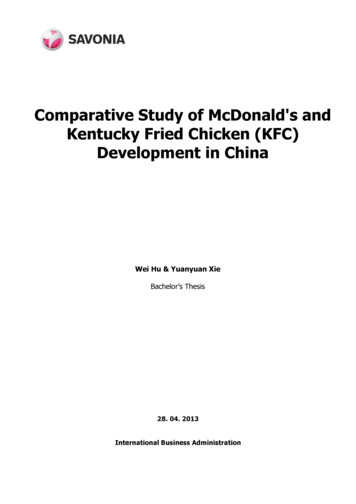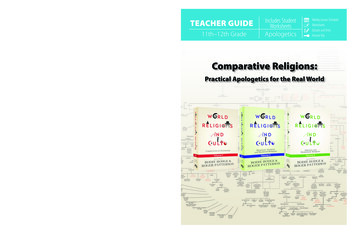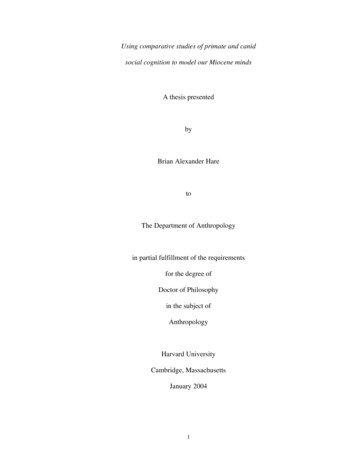
Transcription
Using comparative studies of primate and canidsocial cognition to model our Miocene mindsA thesis presentedbyBrian Alexander HaretoThe Department of Anthropologyin partial fulfillment of the requirementsfor the degree ofDoctor of Philosophyin the subject ofAnthropologyHarvard UniversityCambridge, MassachusettsJanuary 20041
2004 – Brian Alexander Hare2
Table of contentsAbstractpp. ivAcknowledgementspp. vIntroductionPart I: Comparative studies of human cognitive evolution: The future of anthropology?pp. 1Identifying derived features of hominin cognitionPart II: Do chimpanzees know what conspecifics know?pp. 22Part III: Chimpanzees deceive a human competitor by hidingpp. 54Evidence for selection pressures on social cognitionPart IV: Do capuchin monkeys know what conspecifics can and cannot see?pp. 89Part V: Chimpanzees are more skillful in competitive than cooperative cognitive taskspp. 99Part VI: The domestication of social cognition in dogspp. 132The future of comparative studies on human cognitive evolutionPart VII: Can competitive paradigms increase the validity of experiments on primate social cognition? pp. 140Part VIII: Tempering Darwin’s greatest difficulty: How, when, and why did the human mind evolve?Referencespp. 173pp. 2083
4
Brian Alexander HareUsing comparative studies of primate and canidsocial cognition to model our Miocene mindsThesis Advisors: Professors Richard Wrangham, Marc Hauser, and Michael TomaselloAbstractThe greatest challenge facing anthropology is in explaining the evolution ofhuman cognition. The evolution of unique social problem solving skills likely explainmuch of what is unique about our phenotype including language and culture. However,before we can test such hypotheses for the evolution of human cognition, we must firstestablish what cognitive abilities were derived during human evolution. Therefore, formy dissertation research I conducted experiments with chimpanzees to identifying whichsocial cognitive traits our species inherited and which traits have arisen since our splitwith our last common ancestor with chimpanzees and bonobos. Contrary to previousresearch, the current results suggest that the earliest hominins already possessed anincipient mind, which at the very least allowed them to calculate how others perceivedthe world visually. Future work will continue to improve our ability to travel into ourMiocene mind using increasingly sophisticated comparative methodology.5
AcknowledgmentsAs with any other dissertation, mine is not the product of one individual’s laboralone. Instead, this dissertation represents yet another example of how our speciesprospers largely as a result of our unique social cognition and temperament. My parentshave always believed in me far more than I deserved, but I’m sure even they would haveenjoyed the joke, especially after I almost failed out of second grade, if anyone had eversuggested I would finish a Ph.D. – much less from a school anyone had ever heard of.However, despite my inevitable future as a bus boy, countless people worked tirelesslyand selflessly to educate and inspire me to be the best I could be. If it wasn’t for theirintolerance for anything but excellence my academic path, without question, would havebeen much abridged. I have a long way to go, but I can say with confidence, mydissertation, for better or worse, exists only because so many others have not only sharedideas and knowledge with me, but also because they did so with unbridled passion,persistence, and patience. I can only hope, therefore, the sincerity of my gratitude willnot be in doubt as I try to thank the troop of steadfast family, friends, and teachers whonever tire of pushing me up hill as I chase my own selfish dreams.It is impossible for me to thank my parents in words. Without an understanding ofevolutionary theory, I would question their sanity. Why would anyone forfeit so many oflife’s pleasures and comforts, as they always have, in favor of unmitigated investment inthe education of four snot-nosed little brats – myself included? And invest they did,whether it was reading stories, coaching our sports teams, or discussing religion andpolitics, my parents always, always had time and energy for their kids. Of all the lessonslearned from my parents so far, the most valuable are not the ones they taught but instead6
the ones they infected me with. My mom never got tired of reminding me that it was the“lack of my own imagination” anytime I found myself bored. As a child, their was nodefense from her inexhaustible imagination and insatiable desire to learn. How much funwe had finding out about bugs, frogs, bats and every other kind of creature moms do notnormally tolerate, much less enjoy learning about. It cannot be anything but this that ledme, a kid living in a sterile Atlanta suburb, to grow up wanting to learn everything aboutwildlife. What other mother would not only have allowed, but also encouraged her son tobuild his cockroach “farm”? Meanwhile, failure has never been an option for my Dad.Whenever I was frustrated and ready to throw up my hands, he was quick to remind methat, “Can’t never did anything!” My dad knows that winning is fun and hischampionship attitude assures that he has his fair share of victories. Having my padre asmy coach, more than anything, showed me that success requires faith in ones abilitieseven when they don’t seem to be up to the task. However, my education required morethan my parent’s time and inspiration; it also required resources. My parents funded 18years of private education. In deciding what college to attend, instead of pressuring meto accept scholarships at schools that did not offer the program of study I thought I mightbe of interest, they encouraged me to go to Emory so that I might be able to studyprimates – even if it meant they would scrimp and save to foot the bill. In no way am Ithe one who made the greatest sacrifices to see that this dissertation was completed.Thank you Mom and Dad for all your love! I know it wasn’t easy.However my parents were not alone. My grandparents were right there besidethem in helping to encourage and teach. I can remember Mimi being insistent that myold childhood dog’s plate had to be cleaned so that it looked shiny new – even if it was a7
dawg dish. She told me animals deserve to be treated with dignity and respect just asmuch as people. Da was never put-off by the fact that we never caught anything whenwe went fishing every July. The only thing of import was to be outdoors, appreciate thebeauty of nature, and eat a cold watermelon. Grandma was my biggest fan. It didn’tmatter that she hated my pet snakes (she always promised to get me a potbellied pig if Igot rid of them, but unfortunately mom wouldn’t let her!); she never failed to fullysupport my crazy interests. The summers my parents couldn’t afford to send me to“nature camp”, she made sure I got to go, and that I was buried in letters from Grandmaand Da. Given that they were the first in their families to go to college, education was aserious matter to my grandparents. They made sure, using the most positive strategiespossible, that I understood this also.They may not believe it, but I’m thankful to my older siblings Burke and Alicia especially for being the pioneers. I learned a lot about how to behave from watching themgrow up. Much of my confidence came from the knowledge that they had succeeded. Asfor little my little brother Kevin, he might not remember, but we had a ton of funtogether. Does blowing up stuff ever get old? Don’t worry kido your gonna win yourrace.My parents’ willingness to invest so heavily in my education meant that duringmy lifetime as a student I have been taught by some unbelievably talented teachers. Itstarted at The Lovett School: Helen Letts who somehow taught me how to read in thirdgrade; Chatty White who made it cool to love nature; Lynn Eliot who tutored me on herown time at New York Pizza Exchange before my first middle school exams; TomBartelt with his vicious red pen finally taught me how to write a sentence and a paragraph8
in high school; Ken Rau who somehow got me through three years of Latin; Geo PreselyBrooks who gave me the power to beat Joe Bloggs and the SAT. Most significant,perhaps, was Mr. Braddy who introduced me to biology, Darwin, and even his finches onthe Galapagos. No doubt he is the best biologist who has ever taught high school.At Emory, my professor quickly had me sold on human psychology and itsevolution. Harold Gouzoules, Phillippe Rochat, Neil Smith and Frans de Waal all playedkey roles in turning me onto studying cognitive evolution, although it was MikeTomasello who gave me my big break. He let me do science! From the moment I walkedinto his door, I was a teammate whose opinion and contribution were valued. Hecouldn’t have done anything to make it more fun. Equally important was Josep Call, whointroduced me to the chimpanzees. Poor Josep spent countless hours fielding an endlessbarrage of questions – sometimes at two in the morning, when I would hyperactively calland wake him up. He may have been tired, but he never refused to answer and make sureI understood his patient explanation. It was only together with Mike, Josep that Igenerated all of the main ideas pursued within this dissertation while I was at Emory.Finally, I have to thank Pat Marsteller and Richard Wrangham. Independently they eachplayed a critical role in allowing me to live my childhood dream of doing research onchimpanzees in Africa. Dr. Marsteller made sure I had money for the summer research. Ifit was not for her I would not have met Richard Wrangham. Meanwhile, Richard, unlikethe dozens of other field primatologists I tried to contact, instantly said yes to my requestto volunteer at Kanyawara and gave me the chance of a life time. I remember when I gotback the first thing I said to my parents was, “I can die happy now!”9
At Harvard, I have had a cast of superstar advisors. They are amazing as bothscientists and advisors. Perhaps no one has ever taken a bigger chance on me thanRichard Wrangham. He overlooked my pathetic GRE score and mediocre grades andtook me under his wing. I am forever grateful. I'm sure I’ve made him worry about thewisdom of that decision more than once, but he advised me magnificently all the same.His emphasis on theory and his eagle-sharp eye for detail could not have been moreperfect for my intellectual growth. No one has encouraged me more to develop my ownresearch program (or taught me more about Siberian geography). If there is an altruist inthe bunch, it is Marc Hauser. Whether it was engaging me during talks, providing profuseand invaluable comments on manuscripts, or just debating the issues with me, he hasinvested countless hours in my mind (what was left of it from after-hours lab gatherings).Any skill I have at presenting or teaching is also attributed to attempts at emulating Marcand Richard. Can they teach! I also am thankful to Liz Spelke for taking time out of herbusy schedule to be on my defense committee. Her comments at my defense wereextremely constructive. I look forward to learning more. Finally, I have to thank MikeTomasello again. He kept me from starving, kept my teaching load to a minimum, and hedidn’t make me learn German. I especially am thankful given that he probably edited orwrote more of my dissertation than I did. It’s only his ability to pick the wheat from thechaff that keeps our team afloat. All in all, I’m not sure there could be a betterassemblage of people from whom to learn about what it takes to be a scientist. For thatI’m truly lucky.In Boston my survival has been wholly dependent on my friends. I’m especiallythankful for the relative late comers. Cory Miller finally got me to have some fun. Maybe10
a little too much. But it was about time! We’re going to the Congo baby! Sarah Smithfinally, finally took me to see whales! I only had asked ten other people to go with me.I’d forgotten how much fun a girl could be in the snow – even if they do get hurt all thetime. Speaking of fun girls, if ever a girl was fun it is Katarina Mucha. Milo, Guatemala,Mosi, Prague, 9/11, massage therapy, and bike trips to ice cream stores somehowthrough it all we managed to stay the best of friends.But absolutely central to my success and happiness in grad school was “the core.”How much fun have we had! Terry, or the Picky Picky Prof, was my secret weapon. Hewas my political advisor and attitude coach and no one could be more dependable. Hewent so far as to throw a huge party for me before grad school so I could meet his friendsin the Anthropology department. He even drafted key emails for me, when I was toochicken to correspond with professors in the department. Especially early on in graduateschool he played a central role in keeping the dream alive. He refused to listen to any ofmy “disaaaster” scenarios. Instead, he always focused on my big cranium and said justthe right thing to keep my chin up. He is rarely wrong, but when he told me the day Ifound out I got into grad school it would be “the happiest day of your graduate career” hecouldn’t have been more wrong. Instead, largely because of our friendship, the majorityof my days in grad school were my happiest. Not enough can be said about MatthewMcIntyre. He is the MVP. There was no shred of a chance for me in grad school withouthim. No one is more fun to have a discussion with. Period. Regardless of topic Matthewknows too much and can take someone else’s stupid idea (i.e. mine!) and turn it intogenius. How many millions of times have I been totally lost and through discussion withMatthew we solved it. Matthew is always the first person I run to when I am confused11
about any aspect of Scientific enquiry. At the same time, no one has had to endure theinane details of my research life more than he. As a result no one is better at making funof me and no one is more fun to annoy. Professor, I look forward to learning togetherwith ya for a long time. Lest we forget the princess there is Barbara Smith, perhaps, thefunniest girl alive. Why she doesn’t have her own T.V. show “I love bobbi” I will neverknow. Somebody had to take care of all us boys. We would never have know whatmovies to see, what clothes to wear, or how to treat a girl, if it wasn’t for her carefultutelage. Charlotte is so lucky to have such a talented mommy! Finally, there is JudithFlynn and Carole Hooven, probably two of the sexiest women to live. I worshiped my bigsister growing up and likewise I worship them. Both of them tough as nails, and destinedto be wonderful mothers. I remember first year Judith always telling me I would surviveand to “just ignore it.” She was right. Meanwhile, Carole survived an entire year trappedwith me in a 10 x 10 ft office without windows. Thankfully the walls can’t talk! Wereveled in perfecting our profession of being unprofessional. I can only hope to have somuch fun at work again.There are so many other people left to thank I could write another dissertation.All of those listed played a huge roll in helping me to make it to and make it throughgraduate school whether it was helping me take care of chimpanzees, collect data, surviveanother culture, or just have fun. Thank you to Signe Preuschoft, Katja Liebal, ElisabettaVisalberghi, Elsa Addessi, Henriette Zeidler, David Buttelmann, Alicia Perez-Melis,Esther Herrmann, Sandi Voelkner, Allochka, Natalie Ignacio, Irene Plyusnina, LyudmilaTrut, Ray Coppinger, Jerry Kagan, Marc Bekoff, Michael Seres, Fillippo Aureli, JulieMoran, Jennifer Feuerstein, Alberto Palleroni, Jeff Stevens, Laurie Santos, Meg Lynch,12
David Pilbeam, Cheryl Knott, Maryellen Ruvolo, Peter Ellison, Frank Marlow, PeterGray, Joe Marcus, Nathan Young, Glenn Maston, Mikey Steiper, Randy Collura, MartinMuller, Andy Marshall, Sonya Kanhlenburg, Herman Pontzer, Patton Cardwell, theCardwells, the Crafts, Amy Simone, Kristen Mahon, Becca Shapiro, Stephen Brandt,Brian Goff, Matthew Streisfeld, Jony Krickev and Brad Davey.I also must thank the various folks who were willing to fund my graduate schooland various crazy research projects, the most significant of which include the EmorySummer Undergraduate Research Initiative, Harvard University (GSAS) and the MaxPlanck Institute for Evolutionary Anthropology. Also thank you to Alexandra Rosati andSarah Smith for help in editing and preparing my dissertation.Finally, while it may seem silly to some, I have to thank my closest relatives andbest friends (especially Oreo, Daisy, and Milo) who tolerated me and were so much funlearn from. I especially appreciate the efforts of the chimpanzees. There is no real reasonfor them to maintain their interest in being experimented upon. What the chimps mustthink of the weird guy who always wants to give them grapes from underneath cups? Yetthe still love to play, just to play the game. I love it. I hope they continue to help methink of better games while teaching me more about what it is to be human.13
Part I: Comparative studies of human cognitive evolution:The future of anthropology?The challenge of human cognitive evolution.“The greatest difficulty which presents itself, when we are driven to theabove conclusion on the origin of man, is the high standard of intellectualpower and moral disposition which he has attained.”Charles Darwin, The Descent of Man (1871, p. 390).Darwin, of course, was correct. There can be no bigger challenge facingevolutionary theory than explaining the evolution of human cognition. The challengeoriginates from the fact that no evolutionary era in the history of life has resulted in moreradical changes to any one species’ phenotype than those that occurred during homininevolution (Deacon, 1997, Tomasello, 1999; Klein, 1999). At the same time, no area ofanthropological research promises to be richer with discoveries in the next decades thanthe research developing and testing hypotheses of human cognitive evolution (Corballis& Lea, 1999; Barkow et al., 1992). The promise for discovery has emerged with rapidlydeveloping methods that might relax our paleoanthropological dependency, if onlybiological anthropologists resolve to invest more heavily in comparative cognitive studiesof extant species.What is so challenging about the evolution of human cognition? Again, Darwinhimself expresses it best when he says,“We have seen in the last chapter that man bears in his bodily structureclear traces of his descent from some lower form; but it may be urged that,14
as man differs so greatly in his mental power from all other animals, theremust be some error in this conclusion. No doubt the difference in thisrespect is enormous, even if we compare the mind of one of the lowestsavages, who has no words to express any number higher than four, andwho uses no abstract terms for the commonest object or affections, withthat of the most highly organized ape. The difference would, no doubt stillremain immense, even if one of the higher apes had been improved orcivilized as much as a dog has been in comparison with its parent-form thewolf or jackal “ (Darwin, 1871, p. 34).In no more than seven million years our lineage went from species whose few scatteredmembers all independently built sleeping nests each night, to a single species of billions,organized into communities of millions, who together invent everything from baseball torockets with which to fly to the moon. How is such dramatic evolution possible? Amidstthe industrial revolution, Charles Darwin was well aware of the problem that humanintelligence posed for his nascent theory of evolution. Yet before the birth of modernpsychology at the turn of the 20th century, Darwin all but shied away from the problem,only dedicating a few dozen pages of The Descent of Man to an attempt at shrinking thegreat divide between human and nonhuman intelligence. His solution was to suggest thatonly quantitative differences exist between different species of animals including that ofhumans—an idea motivating Skinnerians for most of the 20th century—while onlyoffering a collection of anecdotes as evidence for the plausibility of his case (laterextended further by Romanes, 1882).Although his anecdotes may have carried the day, Darwin clearly saw humancognitive evolution as one of the major challenges that evolutionary biology would haveto tackle with intense and rigorous investigation. Clearly then, any field of inquiry that isserious about solving the mystery of human evolution must address the biggest mysteryof all—that of the evolution of human cognition. Therefore, biological anthropology, the15
only field solely dedicated to the study of human evolution, must overcome its historicapathy towards psychological research and dedicate significant resources towardidentifying what our species’ unique cognitive abilities are, and what evolutionaryprocesses may have led to their evolution. In illustration of this apathy, a recent reviewlays out the future directions for studies of human evolution without mentioning the studyof human cognitive evolution or the potential power of the cognitive sciences (includingcomparative and developmental psychology) in answering questions relevant to humancognitive evolution. Instead the author concludes that, “for all but the last 1-2% of thetime span of an independent human lineage we are forced to rely on a third approach forthe reconstruction of our evolutionary history, namely the location, recovery and analysisof any relevant fossil evidence (Wood, 2000).”How are we, as modern biological anthropologists, going to move toward a viabletheory of human cognitive evolution? One thing is certain: contrary to the supposition ofWood (2000), the staple of physical anthropology—primate fossils—will be relativelyunhelpful in solving many of the mysteries of human cognitive evolution (Mithen, 1996;Tomasello, 1999). Although we can make some important inferences about humancognitive evolution from gross changes in morphology and technology, fossils studied inisolation can neither tell us what specific cognitive changes have taken place nor revealwhat evolutionary processes might have led to those changes (although paleoecologicalreconstructions and paleoanthropological analysis are crucial for generating and testinghypotheses for selection pressures; Klein, 1999). For both these ends there is no otherchoice but to develop comparative methods that allow for the approximation of theproblem solving behaviors of extinct hominoids from that of extant species. Ironically,16
developmental psychologists have already realized the utility of using the comparativemethod for testing ontogenetic theories of human development (Wang & Spelke, 2002;Hauser, 2000). Hopefully in a similar way, anthropologists will also realize howpowerful the comparative studies of animal cognition can be in producing and testinghypotheses relevant to resolving Darwin’s greatest difficulty.The comparative methodTogether evolutionary biologists—including anthropologists and psychologists—have developed an extremely powerful tool for virtual time travel. Careful comparisonbetween extant species can allow for conclusions about the phenotype of these speciesextinct ancestors (Harvey & Pagel, 1991). Inferences regarding ancestral phenotypesthen can be used in accomplishing the ultimate goal of this time travel which is tounderstand what evolutionary mechanisms (i.e. natural selection) have caused thegenotypic changes that result in the phenotypic variance we observe in extant species(Hauser & Fitch, 2002). There are surely different ways to describe the overallcomparative method used across biology, but here I describe it as four sequential stepsbased on Tinbergen’s four levels of analysis (Tinbergen, 1952). However, the sequentialsteps are only meant to aid in explaining the method and do not represent the reality ofhow comparative research is conducted. In fact, multiple research programs are typicallycarried out in parallel allowing researchers to adjust their own hypothesis and techniquesbased on the findings of researchers working on different “steps” of the samecomparative problem.17
The first step necessary for time travel is the identification of shared and derivedtraits across species. Traits can be classified as being shared or derived by applyingsimple rules of parsimony to comparisons between species of know phylogenetic relation(Harvey & Pagel, 1991; Klein, 1999). Shared traits (synapomorphs or plesiomorphs) arethose traits present in close relatives that were inherited through common descent. Forexample, if four relatively closely related species all share a trait, one knows that this traitwas 1) inherited by all species through common descent, and 2) the trait has existed sincebefore the four species speciated (i.e. it is more parsimonious to assume the trait evolvedonly once instead of four times independently) (e.g. Tomasello et al, 1998). Derivedtraits (apomorphs) are those that were not inherited through common descent with othermembers of a clade. For instance, if only one of four closely related species possesses atrait, one knows that this trait 1) is derived since it evolved uniquely during this onespecies evolutionary history, and 2) the trait cannot be older than the species possessing it(i.e. its more parsimonious to assume the trait evolved once instead of being lost threetimes independently) (e.g. Tomasello, 1999; Hauser et al, 2002).The second step to successful time travel is identification of an ecologicalfactor(s) correlated with the observed variance in a trait(s). Ecological factors correlatedwith variance in a trait can be exposed in two ways. First, comparisons between speciescan identify cases of convergence in a trait that correlate with an ecological factor.Convergences represent cases of analogous traits being derived multiple times,independently of one another and across a range of species (i.e. the possibility must beruled out that similar traits are homologous). With the demonstration of convergence, anecological factor(s) shared in common across the species with a homoplasy can be18
nominated as a candidate selection pressure(s) responsible for the documented evolution(e.g. Kamil et al, 1994). Second, comparisons within species can reveal ecological factorsthat may contribute to evolution in a trait. An ecological factor can be nominated as apotential selection pressure in cases where variation within a species correlates withvariation in an ecological factor (e.g. Boag & Grant, 1978; 1981)The third step to successful time travel is the identification of an alteredepigenetic pathway(s) responsible for a derived trait. Once a correlation has beenestablished between an ecological factor and variance in problem solving behavior, it isthen possible to search for an altered epigenetic pathway that may have been affected bypressure from the suspected ecological factor and is responsible for the observed variancein the trait. One way epigenetic pathways can be identified is by comparing individuals orspecies before and after they have been exposed to experience relevant to thedevelopment of the trait under study. For example, depriving or providing individuals ofecologically relevant experiences (i.e. interactions with conspecifics) can prevent orenhance physiological changes (i.e. testosterone levels) that are required for thedevelopment of morphological structures (i.e. neurogenesis) that control the expression ofthe trait under study ( i.e. vocal learning in passerine birds, reviewed in Brainard &Doupe, 2002).The fourth step to successful time travel is the demonstration that natural selectionaltered the implicated epigenetic pathway. Once an epigenetic pathway has beenidentified, in some cases it is possible to demonstrate that this pathway was a target ofselection. Increasingly there will be opportunity to compare levels of nonsynonomous tosynonomous changes in sequences of DNA involved in the expression of the19
developmental pathway(s) in question (e.g. Iwama & Gojobori, 2002; Trut, 2001). If itcan be demonstrated that the genetic architecture responsible for the development ofthese epigenetic pathway were subject to natural selection, then it can be inferred that thesuspected ecological pressure acted as the selection pressure.The comparative method for the study of human cognitive evolutionThe comparative method can be powerfully applied to the study of humancognitive evolution (Wrangham et al, 1999; Tomasello, 1999; Wang & Spelke, 2002;Hauser et al, 2002). However, it is important to recognize from the outset that thequestions we can answer with these methods are constrained by our fate as the solesurviving hominin species (Wood, 2000).The resolution allowed for by the comparative method is completely determinedby the extant species available for comparison. Unimpressively little can be concludedfrom the fossil remains of extinct hominins compared to what would be possible ifcomparative hominin psychologists had even one living individual to study. Therefore,during the period where, perhaps, the greatest changes in any species phenotype isobserved (e.g. human culture and language, Tomasello, 1999; Hauser et al, 2002), wehave the least amount of data to help in establishing when, how and why these changesoccurred during the Plio-Pleistocene (Klein, 1999). Ironically, this means that the mostdifficult period of cognitive evolution to reconstruct, out of the entire history of cognitiveevolution in animals, is the last seven million years of human cognitive evolution(Deacon, 1997). However, although the situation might seem bleak, it is far from20
hopeless. There are three proven methods for attacking the problem of reconstructinghuman cognitive evolution based on the comparative method outlined above.Hominin phylogenetic analysisAlthough our species alone represents t
generated all of the main ideas pursued within this dissertation while I was at Emory. Finally, I have to thank Pat Marsteller and Richard Wrangham. Independently they each played a critical role in allowing me to live my childhood dream of doing research on chimpanzees in Africa. Dr. Marsteller made sure I had money for the summer research. If
